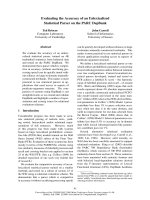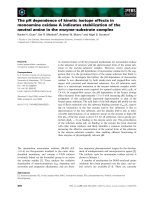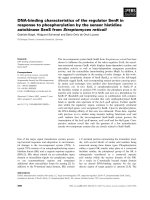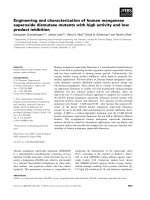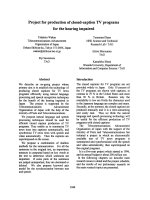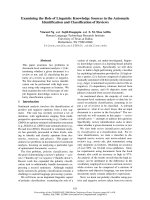báo cáo khoa học: " Minimally invasive application of botulinum toxin A in patients with idiopathic rhinitis" doc
Bạn đang xem bản rút gọn của tài liệu. Xem và tải ngay bản đầy đủ của tài liệu tại đây (489.48 KB, 7 trang )
BioMed Central
Open Access
Page 1 of 7
(page number not for citation purposes)
Head & Face Medicine
Methodology
Minimally invasive application of botulinum toxin A in
patients with idiopathic rhinitis
Saskia Rohrbach
1,2
, Katharina Junghans
1
, Sibylle Köhler
1
and
Rainer Laskawi*
1
Address:
1
Department of Otolaryngology, Head and Neck Surgery, University of Göttingen, Germany and
2
Department of Audiology and
Phoniatrics, Charite, Medical University of Berlin, Germany
Email: Saskia Rohrbach - ; Katharina Junghans - ;
Sibylle Köhler - ; Rainer Laskawi* -
* Corresponding author
Abstract
Background: Nasal hypersecretion due to idiopathic rhinitis can often not be treated sufficiently
by conventional medication. Botulinum toxin A (BTA) has been injected into the nasal mucosa in
patients with nasal hypersecretion with a reduction of rhinorrhea lasting for about 4 to 8 weeks.
Since the nasal mucosa is well supplied with glands and vessels, the aim of this study was to find out
if the distribution of BTA in the nasal mucosa and a reduction of nasal hypersecretion can also be
reached by a minimally invasive application by sponges without an injection.
Methods: Patients were randomly divided into two groups. The effect of BTA (group A, C, D) or
saline as placebo (group B) was investigated in 20 patients with idiopathic rhinitis by applying it with
a sponge soaked with BTA (40 units each nostril) or saline. Subgroups C and D contained these
patients of group A and B who did not improve in symptoms one week after the original treatment
(either BTA or saline) who then received the alternative medication. Changes of symptoms
(rhinorrhea, nasal obstruction) were scored by the patients in a four point scale and counted
(consumption of tissues, sneezing) in a diary. The patients were followed up weeks 1, 2, 4, 8 and 12.
Results: There was a clear reduction of the amount of secretion in group A compared to group
B, C and D. This did not correlate with the tissue consumption, which was comparably reduced in
group A and B, but reduced less in group C and D. Sneezing was clearly reduced in group A but
comparably unchanged in group B and C and increased in group D. Nasal congestion remained
unchanged.
Conclusion: In some patients with therapy-resistant idiopathic rhinitis BTA applied with a sponge
is a long-lasting and minimal invasive therapy to reduce nasal hypersecretion.
Background
Chronic rhinitis is a common condition affecting over
20% of the population [1]. Since patients with rhinitis
form a heterogeneous group, until now there has been no
universally accepted definition for the different entities.
An attempt to take into consideration the pathophysio-
logical mechanisms classified rhinitis in allergic, infectious
and other forms [2]. Other forms include the idiopathic
Published: 16 October 2009
Head & Face Medicine 2009, 5:18 doi:10.1186/1746-160X-5-18
Received: 26 May 2009
Accepted: 16 October 2009
This article is available from: />© 2009 Rohrbach et al; licensee BioMed Central Ltd.
This is an Open Access article distributed under the terms of the Creative Commons Attribution License ( />),
which permits unrestricted use, distribution, and reproduction in any medium, provided the original work is properly cited.
Head & Face Medicine 2009, 5:18 />Page 2 of 7
(page number not for citation purposes)
rhinitis (IR, also referred to as intrinsic, in former times
vasomotor rhinitis), a diagnosis of exclusion which has
not been as extensively investigated as allergic rhinitis [3].
Nevertheless nonallergic rhinitis may be just as common
and disabling for the patient. Studies of prevalence of
nonallergic rhinitis have reported that this ranges from
around 20-50% amongst the rhinitis population [4,5]. All
forms of rhinitis are caused by a permanent, convulsive or
occasional nasal hyperreactivity. Nasal secretion and
nasal patency is mainly controlled by the autonomic nerv-
ous system. Different neuropeptides participate in the
complex innervation of the nasal system, among them
vasoactive intestinal peptide (VIP), calcitonin gene-
related peptide (CGRP), substance P (SP), nitric oxide
(NO) and acetylcholine [6-10]. The discharge of excessive
watery nasal fluids in allergic and non-allergic rhinitis is
caused by an overactivity of the submucosal seromuci-
nous glands and a massive exudation from the mucosal
vasculature. All patients complain about the characteristic
symptoms like nasal obstruction and sneezing, but espe-
cially rhinorrhea is the most obvious symptom to others
and often the most bothering to the patient.
Therapeutic options in treating nasal hyperreactivity
depend on the pathogenesis of the particular type of rhin-
itis and the current complaints of the patient. It includes
allergen reduction, the application of local decongestants
and topical steroids, specific immunotherapy or rhinosur-
gical treatment. Since few of the conventional treatments
yield satisfactory results for reducing rhinorrhea irrespec-
tive how it is caused, further therapies have to be devel-
oped.
Botulinum toxin (BTX) is a neurotoxin that inhibits the
release of acetylcholine from the presynaptic nerve termi-
nal at the neuromuscular and neuroglandular junction
[11]. It is therapeutically used in otorhinolaryngology for
different dysfunctions like spasmodic dysphonia, dys-
phagia, oromandibular dystonia, and facial and cervical
movement disorders. It has also been used in the auto-
nomic nervous system to treat gustatory sweating [12,13]
and sialorrhea [14,15]. Botulinum toxin type A (BTA) has
been injected in the nasal mucosa in patients with IR and
allergic rhinitis to reduce nasal fluids [16,17], having a
stronger effect on the reduction of rhinorrhea than steroid
injection [18].
Shaari et al. [19] demonstrated a decrease in experimen-
tally induced rhinorrhea in dogs after placing gauze with
BTA into the nasal cavity. BTA has been injected in the
nasal mucosa of the lower and middle turbinate mucosa
for allergic and IR by different authors, resulting in a sig-
nificant and up to 8 weeks lasting reduction of nasal
hypersecretion [16,17].
Earlier studies of our group, confirmed by others, showed
a temporary degeneration of submucosal glands of the
turbinate mucosa of guinea pigs after applying BTA with a
sponge [20,21] and a significant reduction of rhinorrhea,
tissue consumption and nasal obstruction in a female
patient with IR after BTA treatment using the same
method [22].
The aim of this study was to verify the results of the single
case study in patients with IR by evaluating subjective
symptomatic relief of rhinorrhea, nasal obstruction and
sneezing and to observe the development of the number
of tissues used after applying BTA minimally invasively
with a sponge.
Materials and methods
The study was approved by the ethic committee of the
Georg-August University of Göttingen, in compliance
with the Helsinki Declaration. All patients gave their writ-
ten informed consent to participate.
Twenty patients with IR (5 female, 15 male, mean age
61.8 ± 10.0) were included into the study. Three patients
did not finish the follow up time because of the long dis-
tance to our hospital and were excluded. Exclusion criteria
were pregnancy or breast feeding, myasthenia, nasal ana-
tomical abnormalities (septal deviation, polyps), acute
infectious rhinosinusitis and simultaneous use of
aminoglycosides. All patients had already a long history
of IR with former treatment with decongestants, topical
steroids or ipratropium bromide without effect. IR was
diagnosed by means of history, clinical examination and
negative skin prick test and in some patients by x-ray of
the sinuses to exclude sinusitis. Patients were randomly
divided into 2 groups:
In group A, 40 units of BTA (Botox
®
, Allergan Inc, Irvine,
California; 1,6 ml = 40 units of BTX-A) were applied (total
80 units). In group B, the corresponding amount of 0.9%
saline was used. Group C and D were these patients who
did subjectively not note any reduction of symptoms
(including all symptoms) one week after the treatment
(either BTA or saline). Those patients were treated for a
second time (other than first formula, group C = first treat-
ment with BTA, second treatment with saline, group D =
first treatment with saline, second treatment with BTA).
The respective liquid (BTA or saline) was dropped on a
sponge which expanded (Merocel
®
, Medtronic Xomed,
Mystic, Connecticut, USA) after it was introduced in each
nostril using bayonet forceps (see figure 1). This design of
double treatment in some patients has been chosen to
increase the compliance of patients. All patients included
had the benefit to get BTA. The sponges stayed in the nose
for 30 minutes and were then removed.
Head & Face Medicine 2009, 5:18 />Page 3 of 7
(page number not for citation purposes)
According to Kim et al. [16] we handed out a nose-diary
in which the patients recorded the number of tissues used
per day (each tissue was only used once), the number of
sneezing per day and scored symptoms like nasal secre-
tion and nasal congestion on a four-point scale (0 = no, 1
= mild, 2 = moderate, 3 = moderate to severe and 4 =
severe), starting two weeks before the first treatment. The
occurrence of a dry nose, smelling disorders or epistaxis
was recorded daily. All patients were advised not to take
any additional nasal therapy. The patients were followed
up week 1, 2, 4, 8 and 12. The inspection of the nose diary,
the patients' over all impression of the treatment and the
clinical examination (anterior rhinoscopy) were done in
every follow up and formed the basis for evaluating the
study.
The sum of the severity of symptoms for each group was
expressed as per cent of the original symptom severity
before treatment (week -1 and -2 until time of first treat-
ment).
Results
The study groups were comprised as follows: group A
(only BTA), n = 3 (1 female, 2 males; mean age 67,3 years;
range 55-80 years); group B (only saline), n = 3 (3 males,
mean age 71,3 years, range 59-80 years); group C (BTA/
saline), n = 7 (2 females, 5 males, mean age 61,6 years,
range 44-73 years); and group D (saline/BTA), n = 4 (2
females, 2 males, mean age 63,5 years, range 52-73 years).
Three patients were lost for follow up because of the long
distance to our hospital. Twelve of 17 (70.6%) patients
realized the treatment, irrespective of what they received,
as positive. The results for each patient can be seen in table
1.
The tissue consumption after 12 weeks in group A (only
BTA) was reduced 42,57%, comparable in group B (only
saline) 35,47%, in group C (BTA/saline) 27,24% and in
group D (saline/BTA) 27,04%. The subjective scored
amount of secretion was reduced in group A (only BTA)
Sponges placed in each nasal cavityFigure 1
Sponges placed in each nasal cavity. The sponges are
attached to a small thread for removal. Once they have con-
tact to liquids, they expand and cover a large area of the
mucosa of the nasal septum and the lower and middle tur-
binates.
Table 1: Overview on all groups after treatment
group n patients tissues secretion congestion sneezing
A 3 IN 3, 11, 16 ▼+▼▼▼▼ ▼∅∅ ▼▼▼
B 3 IN 6, 14, 15 ▼▼▼ +▼▼ ▼▼∅ ▼▼▼
C 7 IN 1, 2, 4, 5, 10, 12, 17, ▼▼++
▼▼▼
▼▼++
▼▼▼
∅▼▼+
∅∅▼
▼▼+▼
+▼▼
D 4 IN 7, 9, 13, 18 ▼▼▼▼ +▼∅▼ ∅∅∅▼▼▼▼+
Results for all patients of group A-D concerning tissue consumption, nasal secretion, congestion and sneezing.▼ decreased,∅ no change,+
increased, IN = intrinsic rhinitis
Head & Face Medicine 2009, 5:18 />Page 4 of 7
(page number not for citation purposes)
46,39%, but in group B (only saline) 6,12%, in group C
(BTA/saline) 24,70% and in group D (saline/BTA)
13,37%. The tissue consumption and the subjective
scored amount of secretion did not correlate. Note the tis-
sues used in group B compared to the amount of reduc-
tion of nasal secretion (reduction 35,47% versus 6,12% of
reduction of nasal secretion). Nasal congestion was scored
also and was reduced in group A (only BTA) 9,66%, in
group B (only saline) 20,90%, in group C (BTA/saline)
27,72% and in group D (saline/BTA) 52,38% (n = 1).
The symptom "sneezing" was reduced 68,46% in group A
(only BTA), but only 17,74% in group B (only saline),
17,41% in group C (BTA/saline) and increased 14,91% in
group D (saline/BTA) (see figure 2). The time courses for
the reduction of nasal secretion can be seen in figure 3. A
dry nose, smelling disorders or epistaxis did not occur in
our patients.
Discussion
The effect of BTA on glands has been described for differ-
ent organs [16,19-23]. The way of its action in the nose
has been postulated to be the inhibition of the release of
acetylcholine from the pre-ganglion cholinergic nerve
endings in the nasal mucosa, the inhibition of the release
of acetylcholine from the pre-ganglion cholinergic nerve
endings in the sphenopalatine ganglion and the induction
of apoptosis of nasal glands [16,19,20].
However, not all glands seem to be influenced (group A,
C and D). Shaari et al. [16] obtained an average decrease
in rhinorrhea of 41% in dogs' experimentally induced rhi-
norrhea. One out of four dogs even showed an increase in
secretion. Own results in adult guinea pigs nasal glands
showed about 60% of degeneration after treatment with
40 units BTA (Botox
®
) with a sponge [20]. Apart from the
fact that the area the toxin is able to reach after local appli-
Percentual reduction of tissue consumption, nasal secretion, nasal congestion and sneezing for group A-D 12 weeks after the treatmentFigure 2
Percentual reduction of tissue consumption, nasal secretion, nasal congestion and sneezing for group A-D 12
weeks after the treatment. A clear decrease of nasal secretion and sneezing in group A (only BTA) is obvious. Note that
group D shows an increase of sneezing 12 weeks after treatment.
Head & Face Medicine 2009, 5:18 />Page 5 of 7
(page number not for citation purposes)
cation is restricted, the partial effect may be due to the
abundance of other neuropeptides that are included in
regulating the homeostasis of nasal secretion [24], but not
influenced by an anticholinerg drug like BTA. On the
other hand it is postulated that BTA also influences the
effect of other neuropeptides in nasal secretion [6]. This
might be the cause for the reduction of nasal secretion in
some of our patients who did not show an effect after
treatment with ipratropium bromide (anticholinerg) but
who did show a reasonable effect after treatment with
BTA. In some patients who were treated with BTA
(patients of group C and D) we could not confirm a rea-
sonable change in symptoms even though they were
treated with BTA after they received saline first or after the
treatment with BTA. We can not explain this phenomenon
but we do not know the exact pathophysiological mecha-
nism of IR, so in some patients acetylcholine might play a
minor role in causing nasal hypersecretion. It seems as if
we have to deal with a BTA sensitive rhinitis, which would
be interesting to differentiate from other forms of nonal-
lergic rhinitis.
We decided to introduce the toxin into the nose via small
self-expanding sponges which, once having contact with
the fluid, filled out the whole nasal cavity without letting
any substance drop into the nasopharynx. Since the nasal
mucosa is a very permeable tissue to absorb and excrete
substances and since this method showed a serious effect
on guinea pigs nasal glands, we carried out this minimally
invasive and less painful method to reach a bigger area of
nasal glands. Throughout the application time of 30 min-
utes, the patients could breathe through the mouth with-
out any problems. The fact that not all patients who were
treated reported an improvement is not restricted to our
patients in this study, but is also known in patients which
underwent BTA-injections into the nasal conchae to treat
IR [16,17]. In contrast to the injection, by our method we
do not exactly know which amount of BTA really reached
the mucosa.
Before treating the patients, we had to decide which dose
of BTA should be applied. Shaari et al. [19] used 50 units
in soaked gauze to one nasal cavity in dogs. Others
injected between 4 to 60 units BTA into the mucosa of the
lower turbinates [16,25,26]. In guinea pigs and in one
patient with IR, we applied 40 units BTA on a sponge
[20,22]. To reach an intense and long-lasting effect even
in patients with severe symptoms, we used 40 units per
nasal cavity (total 80 units).
Results of nasal secretion week -2 to week 12 for all groups in %Figure 3
Results of nasal secretion week -2 to week 12 for all groups in %. Note the clear decrease of the amount of nasal
secretion in group A (only BTA) compared to group B, C and D.
Head & Face Medicine 2009, 5:18 />Page 6 of 7
(page number not for citation purposes)
The symptom scores concerning the amount of secretion
was clearly reduced in group A compared to group B, C
and D. Interestingly, this did not correlate with the tissue
consumption, which was comparably clearly reduced in
group A and B, but reduced less in group C and D. One
can speculate that the "use of tissues" intensely depends
on the subjective assessment of patient and is therefore
more than the other symptoms exposed to the patients'
expectance. This study and other investigation on the
influence of BTA on nasal secretion show that we need an
objective indicator for the reduction of nasal secretion
(i.e. with weighing a sponge introduced in the nose before
a respective treatment and on a representative time after
the treatment).
Sneezing was clearly reduced in group A but later and to a
lesser degree in group B, C and D. Unal [17] described a
significant reduction of sneezing in patients with allergic
rhinitis after treatment with 40 or 60 units Botox
®
,
whereas Kim et al. [16] did not report on a reduction in
sneezing in patients with intrinsic rhinitis. Our findings
might indicate an important role of acetylcholine as a rel-
evant neurotransmitter in the sneezing reflex.
Most of our patients did not suffer from nasal congestion
neither before nor after the treatment, which is more fre-
quent in allergic rhinitis. The subjects have traditionally
been classified as either "runners" (predominantly rhinor-
rhea) or "blockers" (predominantly nasal congestion),
but many patients suffer from more than one symptom.
Unal et al. [25], who treated patients with allergic rhinitis,
showed a significant reduction in nasal congestion after
injection of BTA. Nasal congestion in most of our patients
of all groups did not change (only 1 patient in group D
reported about reduction of nasal stuffiness), which con-
firms the results of Kim et al. [16] in patients with IR.
Since nasal congestion is mainly regulated through the
nasal vessels and not directly under the influence of ace-
tylcholine, we did not expect a difference in nasal stuffi-
ness. It is only imaginable that an improvement in nasal
air flow occurs secondarily through a significant reduction
of glandular volume.
Other groups who used BTA for nasal symptoms
described a duration of effect for 4 to at least 8 weeks
[16,25]. In our patients the reduction of all symptoms
described, once occurred, lasted for at least 12 weeks. In
adult guinea pigs, we could show a degeneration of sub-
mucosal glands after treatment with BTA applied with the
same method (sponge). Regeneration was seen after 12
weeks [20]. The longer time of effect in those patients,
who felt a reasonable reduction of rhinorrhea might be
due to the dose but also to the application method we
used, reaching an extended mucosal area with the possi-
bility to block a maximum of nasal glands.
Even none of the patients reported about an increase in
symptoms after treatment, some of the BTA treated sub-
jects did not describe any improvement compared to
other studies [16,25,26]. Since we do not know the exact
pathophysiological mechanism of IR, in some patients
acetylcholine might play a minor role in the origin of
hypersecretion.
Conclusion
This study could show that in some patients with IR, the
minimally invasive application method of BTA with a
sponge is a save, painless method which can lead to a long
lasting reduction of nasal hypersecretion. Further studies
should investigate methods to objectify the patients'
symptoms, especially the amount of nasal secretion, and
yield results in the question of dosages of BTA-application
in the nose. A greater amount of patients could yield reli-
able results through statistical analysis.
Competing interests
The authors declare that they have no competing interests.
Authors' contributions
SR treated the patients, interpreted the results and drafted
the manuscript. KJ and SK treated the patients and partic-
ipated in constructing the tables.
RL conceived of the study, and participated in its design
and coordination and helped to draft the manuscript. All
authors read and approved the final manuscript.
References
1. Jones NS, Carney AS, Davis A: The prevalence of allergic rhinos-
inusitis: a review. J Laryngol Otol 1998, 112(11):1019-1030.
2. Carney AS, Jones NS: Idiopathic rhinitis: idiopathic or not? Clin
Otolaryngol Allied Sci 1996, 21(3):198-202.
3. Bachert C: Persistent rhinitis - allergic or nonallergic? Allergy
2004, 59(Suppl 76):11-15.
4. Skoner DP: Allergic rhinitis: definition, epidemiology, patho-
physiology, detection, and diagnosis. J Allergy Clin Immunol 2001,
108(1 Suppl):S2-8.
5. International Consensus Report on the diagnosis and management of
rhinitis: International Rhinitis Management Working Group.
Allergy 1994, 49(19 Suppl):1-34.
6. Baraniuk JN, Kaliner MA: Neuropeptides and nasal secretion.
Am J Physiol 1991, 261:L223-235.
7. Jeon SY, Majima Y, Kawaguchi S: Immunohistochemical and elec-
tron microscopic studies of substance P in guinea pig nasal
glands. Acta Otolaryngol Suppl (Stockh) 1993:41-46.
8. Kondo T, Inokuchi T, Ohta K, Annoh H, Chang J: Distribution,
chemical coding and origin of nitric oxide synthase-contain-
ing nerve fibers the guinea pig nasal mucosa. J Auton Nerv Syst
2000, 80:71-79.
9. Rohrbach S, Olthoff A, Laskawi R, Götz W: Neuronal nitric oxide
synthase-immunoreactivity. A neuromodulating system
independent of peripheral nasal gland denervation in guinea
pig nasal mucosal tissue after treatment with botulinum
toxin type A. ORL J Otorhinolaryngol Relat Spec 2002, 64(5):330-334.
10. Olthoff A, Rohrbach S, Faber M, Götz W, Laskawi R: Neuronal
nitric oxide synthase immunoreactivity in the nasal mucosa
of patients with idiopathic and allergic rhinitis. ORL J Otorhi-
nolaryngol Relat Spec 2002, 64(3):180-185.
11. Jankovicz J, Brin MF: Therapeutic uses of botulinum toxin. N
Engl J Med 1991, 324:1186-1194.
Publish with BioMed Central and every
scientist can read your work free of charge
"BioMed Central will be the most significant development for
disseminating the results of biomedical research in our lifetime."
Sir Paul Nurse, Cancer Research UK
Your research papers will be:
available free of charge to the entire biomedical community
peer reviewed and published immediately upon acceptance
cited in PubMed and archived on PubMed Central
yours — you keep the copyright
Submit your manuscript here:
/>BioMedcentral
Head & Face Medicine 2009, 5:18 />Page 7 of 7
(page number not for citation purposes)
12. Laskawi R, Drobik C, Schoenebeck C: Up-to-date-report of botu-
linum toxin type A treatment in patients with gustatory
sweating (Frey's syndrome). Laryngoscope 1998, 108:381-384.
13. Laskawi R, Ellies M, Rödel R, Schoenebeck C: Gustatory sweating:
clinical implications and etiologic aspects. J Oral Maxillofac Surg
1999, 57:642-649.
14. Beuche W, Arglebe C, Laskawi R: Quantitative reduction of
saliva production in two ALS patients with intraglandular
injections of botulinum toxin. Neurol Psychiatry Brain Res 2000,
8:23-26.
15. Ellies M, Laskawi R, Rohrbach-Volland S, Arglebe C, Beuche W: Bot-
ulinum toxin to reduce saliva flow: selected indications for
ultrasound-guided toxin application into salivary glands.
Laryngoscope 2002, 112(1):82-86.
16. Kim KS, Kim SS, Yoon JH, Han JW: The effect of botulinum toxin
type A injection for intrinsic rhinitis. J Laryngol Otol 1998,
112(3):248-51.
17. Unal M, Sevim S, Dogu O, Vayisoglu Y, Kanik A: Effect of botulinum
toxin type A on nasal symptoms in patients with allergic
rhinitis: a double-blind, placebo-controlled clinical trial. Acta
Otolaryngol 2003, 123(9):1060-3.
18. Yang TY, Jung YG, Kim YH, Jang TY: A comparison of the effects
of botulinum toxin A and steroid injection on nasal allergy.
Otolaryngol Head Neck Surg 2008, 139(3):367-371.
19. Shaari CM, Sanders I, Wu BL, Biller HF: Rhinorrhea is decreased
in dogs after nasal application of botulinum toxin. Otolaryngol
Head Neck Surg 1995, 112(4):566-71.
20. Rohrbach S, Olthoff A, Laskawi R, Giefer B, Götz W: Botulinum
toxin type A induces apoptosis in nasal glands of guinea pigs.
Ann Otol Rhinol Laryngol 2001, 110(11):1045-50.
21. Wang J, Chen F, Meng M, Zhang X, Chen Y, Huang W, Wang Y: The
influence of botulinum toxin type A on vasomotor rhinitis
and morphological study. Lin Chuang Er Bi Yan Hou Ke Za Zhi
2003, 17(11):643-5.
22. Rohrbach S, Laskawi R: Minimally invasive application of botuli-
num toxin type A in nasal hypersecretion. ORL J Otorhinolaryn-
gol Relat Spec 2001, 63(6):
382-4.
23. Doggweiler R, Zermann DH, Ishigooka M, Schmidt RA: Botox-
induced prostatic involution. Prostate 2001, 37(1):44-50.
24. Knipping S, Riederer A, Agha Mir Salim P, Holzhausen HJ, Berghaus A:
Basic classical, peptidergic and nitrergic innervation pattern
of human nasal glands - a histochemical and immunohisto-
chemical study. Laryngorhinootologie 2001, 80(12):697-703.
25. Unal M: Investigate the effect of botulinum toxin type A
(BTX-A) on nasal symptoms in patients with allergic rhinitis.
Acta Otolaryngol 2005, 125(2):223.
26. Ozcan C, Vayisoglu Y, Dogu O, Gorur K: The effect of intranasal
injection of botulinum toxin A on the symptoms of vasomo-
tor rhinitis. Am J Otolaryngol 2006, 27(5):314-318.
